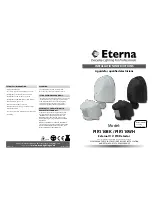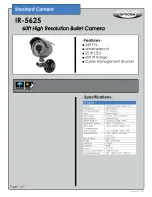
TROUBLESHOOTING AND USER HINTS:
Note:
all passive infra red detectors are more sensitive in cold and dry weather than warm and wet
weather.
PROBLEM
POSSIBLE CAUSE
SUGGESTED REMEDY
Light does not switch
on when there is
movement in the
detection area.
1. No mains voltage
Check all connections, and MCB Fuses /
switches
2. Nearby lighting is too bright
Redirect sensor or relocate the unit
3. Controls set incorrectly
Readjust sensor angle or control knob
4. Lamp blown
Check lamp functions and replace if
necessary
5. Lamp not fitted correctly
Make sure the lamp is correctly seated in
the lampholder
6. Wired incorrectly
Check wiring and confirm its wired as per
the wiring diagram
7. Sensor positioned in wrong direction
Adjust angle and direction of PIR for best
results walk across beam
Light switches on for
no apparent reason
(false trigger)
1. Heat from lamp body activating sensor
Adjust PIR sensor or floodlight to allow
a minimum gap of 40mm between
floodlight body and sensor head
2. Heat sources such as air-con, vents, heaters,
flues, other outside lighting, moving cars
trees or shrubs are activating sensor
Adjust direction of sensor head away from
these sources
3. Animals / birds activating sensor
Redirecting sensor head may help
4. Interference from on/off switching of
electric fans or lights on the same circuit as
your security floodlight.
(This problem does not always occur but a
faulty switch or noisy fluorescent light may
cause the security floodlight to switch on)
Should the false triggering become,
troublesome, consider:
(a) Replacing a faulty switch
(b) Replacing noisy fluorescent tubes and/
or starters
(c) Connecting the floodlight to a separate
circuit (in most cases where one or
more of the above suggestions have
been carried out, false triggering has
been reduced)
5. Reflection from swimming pool, or
reflective surface such as smooth white
walls
Redirect sensor
Light remains on
1. Continuously false triggered
Redirecting sensor head may help
2. Time is set to long
Reduce time
Light remains on at
nighttime
Possible heat source in detection zone
Cover PIR sensor lens with a thick cloth, if
the light turns off check detection area for
heat or reflective source, reposition head
Light switches on
during daylight hours LUX control knob is set to daylight position
Turn the LUX control knob to desired light
level setting
When setting the lux
controls in daylight
the detection
distance becomes
shorter
Interference by sunlight
Re-test at night
UNDERSTANDING THE CONTROLS:
(Referring to Fig. 5 below)
ADJUSTING THE DURATION TIME:
the length of
time that remains switched on after activation can
be adjusted from (10±5) seconds to (4±1) minutes;
rotating the TIME knob from (+) to (-) will reduce
the duration time.
NOTE:
Once the load-light has been triggered by
the PIR sensor any subsequent detection will start
the timed period again from the beginning.
ADJUSTING THE LUX CONTROL LEVEL:
the
lux control module has a built-in sensing device
(photocell) that detects daylight and darkness.
Rotating the LUX knob clockwise from light (
) to
dark (
):
The (
) position denotes that the unit can work
at day and night.
The (
) position denotes that the unit only works
at night.
You can set the PIR to operate the unit at the
desired level by adjusting the LUX knob.
SETTING THE CONTROLS:
1) Put the LUX control knob to light (
) position,
turn the power on and wait half a minute for the
control circuit to stabilize. At this stage ensure
that the TIME control knob is set at minimum
duration time (-) position (rotating the TIME
knob clockwise to stop-position). The load-light
will now switch on and remain on for about 30
seconds.
2) Direct the sensor toward the desired area to be
scanned by adjusting the swivel joint on the
sensor arm.
3) Have another person move across the centre
of the area to be scanned and slowly adjust the
angle of the sensor arm until the unit senses
the presence of the moving person, causing the
load-light to switch on (refer to Fig. 2).
4) Adjust time control to required setting.
5) To set the light level at which the load-light
will automatically switch “on” at night, turn the
LUX control knob from daylight (
) to night
(
). If the load-light is required to switch on
earlier, e.g. dusk, wait for the desired light level,
then slowly turn the LUX control knob towards
daylight while someone walks across the centre
of the area to be detected. When the load-light
switches on, release the LUX control knob.
You may need to make further adjustments to
achieve your ideal light level setting.
Important: To avoid dust build-up and ensure
proper functioning of the PIR Sensor, please
wipe the sensor lens lightly with a dry cloth
every 3 months.
TIME
LUX
Fig 5




















